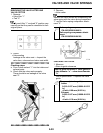
4-27
VALVES AND VALVE SPRINGS
b. Apply molybdenum disulfide oil to the valve
stem.
c. Install the valve into the cylinder head.
d. Turn the valve until the valve face and valve
seat are evenly polished, then clean off all of
the compound.
For best lapping results, lightly tap the valve
seat while rotating the valve back and forth be-
tween your hands.
e. Apply a fine lapping compound to the valve
face and repeat the above steps.
After every lapping operation be sure to clean
off all of the compound from the valve face and
valve seat.
f. Apply Mechanic's blueing dye (Dykem) to
the valve face.
g. Install the valve into the cylinder head.
h. Press the valve through the valve guide and
onto the valve seat to make a clear pattern.
i. Measure the valve seat width again. If the
valve seat width is out of specification,
reface and relap the valve seat.
CHECKING THE VALVE SPRINGS
1. Measure:
• Valve spring free length "a"
Out of specification → Replace.
2. Measure:
• Compressed spring force "a"
Out of specification → Replace.
b. Installed length
Free length (valve spring):
Intake:
40.76 mm (1.60 in)
<Limit>: 39.76 mm (1.57 in)
Exhaust:
37.01 mm (1.46 in)
<Limit>: 36.01 mm (1.42 in)
Compressed spring force:
Intake:
178–204 N at 34.78 mm (18.2–20.8
kg at 34.78 mm, 40.01–45.86 lb at
1.37 in)
Exhaust:
124–142 N at 30.83 mm (12.6–14.5
kg at 30.83 mm, 27.88–31.92 lb at
1.21 in)


















